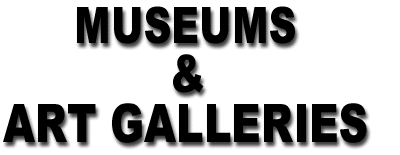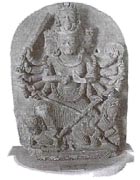

 |
 |
After you’ve had your fill of watching the mountains, touring the monuments and ransacking the shopping centers, there’s nothing like browsing around the museums for some quiet indoor relaxation.
The National Museum at Chhauni near Swayambhu offers breathtaking bronzes and a rich collection of paubha scroll paintings. It also has an extraordinary collection of ancient firearms, leather cannons and relics of the Great Earthquake of 1934. Open daily, except Sundays, Mondays and holidays, from 9:00 am to 4:30 pm. Entrance fee Rs. 10 for SAARC nationals and Rs. 50 for other foreign visitors. An extra Rs. 50 for cameras and Rs. 100 for video cameras. (Tel: 271478).
The National Numismatic Museum, housed in the Mahendra Memorial Building of the National Museum at Chhauni, contains an exceptional Nepalese coin collection spanning the Lichhavi and Malla dynasties (2nd to 18th century AD) as well as the Shah dynasty. Open daily, except Sundays, Mondays and holidays, from 9:00 am to 4:30 pm. Your entrance ticket to the National Museum entitles you to visit the coin museum also. (Tel: 278009).
The Tribhuvan Museum inside the Hanuman Dhoka Palace in Kathmandu Durbar Square highlights the life of King Tribhuvan (1906-1955) who helped liberate the country from the Rana regime in 1951. The galleries also have rare photographs, paintings and portraits of other Shah rulers and members of the Royal family. Cameras are not allowed. Open daily, except Sundays, Mondays and holidays, from 9:15 am to 4:00 pm. Entrance fee is Rs. 250. (Tel: 258034).
The Mahendra Museum at the Hanuman Dhoka Palace complex vividly sheds light on the life of late King Mahendra (r. 1955-1972). His cabinet room, office chamber and personal belongings such as medals, decorations, gifts, coins, stamps, and his literary creations are on exhibition in the museum. Open daily, except Sundays, Mondays and holidays, from 9:15 am to 4:00 pm. You can visit the Mahendra Museum with your ticket to the Tribhuvan Museum. (Tel: 258034).
The Museum of Natural History behind the Swayambhu stupa has exhibits on animals, butterflies and plants. Stuffed animals, birds and crocodiles are a big draw in the museum. Open daily, except Saturdays and holidays, from 10 am to 5 pm. The entrance fee is Rs. 20 and an additional Rs. 20 for cameras. (Tel: 271899).
National Library. Located inside Harihar Bhavan in Pulchowk, Patan, the library contains about 70,000 books, most of which are in English, with a smattering of books in Sanskrit, Nepali, Hindi and Nepalbhasa. The National Library preserves some rare scholarly books in Sanskrit and English dating from the 17th century. Open daily except Saturdays, Sundays and holidays, from 9 am to 5 pm. (Tel: 521132).
Kaiser Library. Collections of a single man, Kaiser Shumsher Jung Bahadur Rana (1891-1964), adorn this palatial building near Thamel. The repertoire of books here (over 45,000) covers as unrelated topics as astrology and law, with history, hunting, religion and philosophy in between. Open daily except Saturdays, Sundays and holidays, from 9 am to 5 pm. (Tel: 411318).
Asa Archives. Located on the western fringe of the old part of Kathmandu, the archives possess an exceptional collection of about 7,000 loose-leaf handwritten books and over 1,200 palm-leaf documents. The oldest manuscript in the collection here is dated AD 1242. Most of the manuscripts are in Sanskrit and Nepalbhasa languages. Asa Archives (Asa Saphu Kuthi), located at Tengal west of Nhyokha Tol, are open daily from 11 am to 5 pm except Saturdays and holidays. (Tel: 263417).
The National Birendra Art Gallery at the Nepal Association of Fine Arts (NAFA) at Naxal has a collection of about 150 art pieces by prominent Nepalese artists. Art exhibitions are organized regularly where paintings can be bought. NAFA also has studios where artists can be seen at work. Open daily except Saturdays, Sundays and holidays, from 9 am to 5 pm. Entrance fee Rs. 25 (SAARC) and Rs. 75 for other foreign visitors. (Tel: 411729)
Patan Museum inside Patan Durbar in the Durbar Square specializes in bronze statues and religious objects, which add up to nearly 200 items. Some of the art goes back to as early as the 11th century. Most of the statues are of Buddha, Bishnu, Lokeswar and Devi, covering both the Hindu and the Buddhist iconology. Open daily, except holidays, from 10:30 am to 5 pm. Entrance fee is Rs. 30 for SAARC nationals and Rs. 120 for other foreign visitors. (Tel: 521492).
The National Art Gallery in Bhaktapur is housed in the old Malla Palace of 55 Windows in the Bhaktapur Durbar Square. The gallery has a rich collection of paubha scroll paintings, bronze, brass, stone and wooden images. Open daily, except Sundays, Mondays and holidays, from 9:30 am to 4:30 pm. Entrance costs Rs. 10 for SAARC nationals and Rs. 20 for other foreign visitors. (Tel: 610004).
The National Woodworking Museum in Tachapal Tol (Dattatreya Square), Bhaktapur, is in the restored 15th-century Pujari Math building built by the Malla king, Yaksha Malla. The Pujari Math is a museum in itself, with the very finest of Newar woodcarving including the famous Peacock Window. Open daily, except Sundays, Mondays and holidays, from 9:30 am to 4:30 pm. Entrance fee Rs. 20 and an extra Rs. 20 for cameras. (Tel: 610005).
The Bronze and Brass Museum is in a 15th-century building opposite the Pujari Math at Tachapal Tol, Bhaktapur. A rich collection of domestic and ceremonial metalware is exhibited in the museum: kalash (ritual jars), ink-pots, spittoons, ordinary and ritual lamps. Open daily, except Sundays, Mondays and holidays, from 9:30 am to 4:30 pm. Entrance fee is Rs. 20 and an extra Rs. 20 for cameras. (Tel: 610448).
OUTSIDE KATHMANDU
The Dhankuta Museum is a regional museum encompassing the eastern sector of the country. Dhankuta is the headquarters of the Eastern Development Region and is located north of Dharan and Biratnagar. Apart from serving as a showcase for ethnic artifacts, the museum focuses on archeological exhibits. Open daily except Tuesdays and holidays from 10 am to 5 pm. Entrance fee is Rs. 5 (Tel: 026-20248) and an extra Rs. 10 for cameras.
The Hattisar Museum and Fish Exhibition Room at Bhimphedi, Makwanpur, houses a rare collection of cages built by Rana prime minister Jung Bahadur, plates depicting the Nepalese and British crowns, and hunting attires.
The Elephant Museum is situated at the old Hattisar or elephant stables at Bhimphedi, Makwanpur. Elephant howdahs, totalling 85, brought from England and various other countries by the Rana prime ministers (1846-1950) for their journeys by elephant have been preserved here.
The Mustang Eco Museum is located about 15 minutes’ walk from Jomsom airport. The ground floor of the museum houses a collection of beads, bones and pendants as well as ceramic vessels found at the burial caves of Mustang. The relics date to 800 BC. There are also musical instruments, costumes and mannequins that reflect the culture of Mustang. A floor above is the Herbal Medicine section. Open 8 to 11 am and 2 to 5 pm.
The Tharu Cultural Museum is located at Thakurdwara, near the entrance of the Royal Bardia National Park in western Nepal. The Tharus are an indigenous people of the Terai with a colorful culture. The museum possesses exhibits like costumes, accessories and household objects which highlight the art, traditions and lifestyle of the Tharu people.
MD Publishing Co.
Pvt. Ltd.,
Tripureswor, P. O. Box 3525, Kathmandu, Nepal.
Tel: 260327, 256003 . Telex: 2611 EMC NP. Fax: 977-1-261159.
E-mail:nttj@mos.com.np
Design and Maintained by Amaa Network Consultant, Inc.
Last Updated: 24 July, 2000
Comments and Suggestions to: Webmaster